You’ve set up your website, researched SEO and growth marketing agencies, read about using a blog to gain inbound leads. Now it’s decision time. Where will you spend your marketing dollars to help your business grow? Is inbound marketing the right choice?
Wait. What is inbound marketing?
Here’s the quick answer ⤵
Inbound marketing refers to a digital marketing methodology that relies on attraction or ‘pull’ marketing tactics to draw people to a business and its products or services. Common inbound marketing methods include publishing online content such as blogs and videos as well as posting, sharing and engaging with content on social media.
The organic and non-intrusive nature of inbound marketing distinguish it from outbound marketing methods that employ paid channels and are often disruptive. Inbound marketing invites audiences to come to your brand, while outbound methods pursue audiences’ attention.
Keep reading to discover more about the foundations and history of inbound marketing, why it works and how you can make it work for your business.
Characteristics and origins of inbound marketing: How do you know it’s inbound?
Inbound marketing has its roots in the pre-internet strategies of relationship and attraction marketing. This specific methodology rose from the adoption of these and other marketing practices for a digital world.
Inbound marketing
-
- Uses digital marketing channels
- Distributes content through owned or earned media
- Gives value freely
- Is permission-based and non-disruptive
- Aims to attract, engage, and delight
- Minimizes sales language and direct asks
- Targets audiences and individuals with tailored content
- Is a customer-first, growth focused approach to marketing
Where did the term inbound marketing originate?
The term, “inbound marketing” first arrived on the scene along with the brand responsible for its origination, HubSpot, in 2006. The business founded by Brian Halligan and Dharmesh Shah provided support for small businesses to harness the power of the internet to attract and convert leads.
HubSpot’s core offering was internet marketing support using inbound marketing software that enabled businesses “get found” online.
How?
HubSpot’s inbound methodology promotes engagement by producing attractive content that answered people’s questions and invited them to begin a conversation with the brand. Instead of going out in search of leads, inbound methods bring a flow of prospect to the business’s home base–its website.
Of course, lots of marketing strategies use attraction or pull tactics to acquire customers and increase revenue. From physical stores’ window displays to branded digital games, businesses engage in “know, like, trust” marketing to raise awareness and build loyalty.
These tactics aim to build relationships as a precursor to getting the sale, and various strategies go by different names depending on their format and channel.
Inbound marketing’s particular collection of attraction marketing techniques is limited to the digital realm because the term was created to differentiate those methods from what came before.
Inbound marketing strategy and implementation fundamentals
The inbound marketing methodology, as envisioned by HubSpot and employed today, involves more than just building websites and hoping they will come. Creating and publishing content is a core component of an inbound strategy.
But this content must be strategically selected and distributed. Otherwise, its potential is wasted.
Successful inbound content must be valuable, relevant, timely and discoverable.
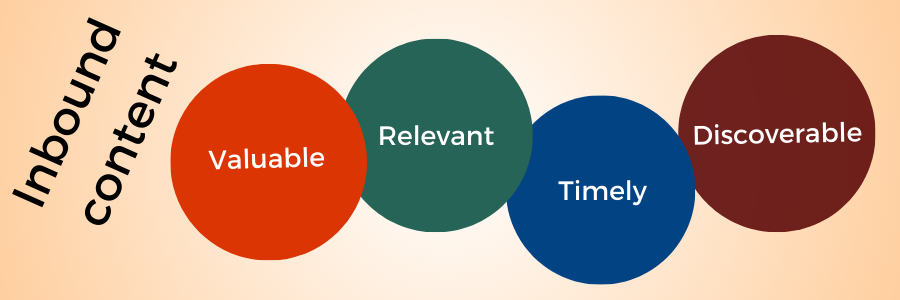
What does this mean?
You may have heard this concept referred to as, “Right audience, right message, right time.” Add to this, “right channels” as modern consumers expect brands to meet consumers in their desired environments.
When businesses use outbound advertising tactics, they choose their audience, message, timing and channel by setting the parameters of the ad. If the ad is well-aimed, it should appear in front of the desired audience at or near the right moment.
When you use inbound marketing, your audience decides when and where to look for your content and whether they’ll respond to your enticements.
To succeed in attracting and engaging prospects, inbound marketers must identify what information is valuable to their ideal prospect or customers.
Answering people’s questions, explaining and offering solutions to their problems, entertaining them or providing something that deserves their attention is what makes content valuable.
Of course, there are times when content is attractive without connecting to your brand or its products or services. A funny meme or a thoughtful greeting can get someone to stop what they are doing and pay attention to your business momentarily. Ideally, your inbound content should be both attention-getting and relevant.
Why spend money on name recognition alone when you can gain name recognition and move your prospects further along their path to purchase? 💁♀️
Delivering content that meets people’s needs at each stage of their journey is how brands achieve relevance and timeliness.
Someone who doesn’t know they want your product or service yet will not respond to the same content or appeal as someone who is ready to make an immediate purchase.
Getting the content in front of your audience at the moment it is most valuable is the point of timeliness and building content for each stage of the buyer’s journey. Then, it’s just a matter of ensuring that this content is distributed across the channels your audience uses to find answers and optimizing it for discoverability.
Finally, discoverability 🔎 is essential because one of the challenges and benefits of an inbound marketing strategy is that no two buyer’s journeys are the same.
A person who is thinking about buying a new refrigerator might start their journey by searching for refrigerator prices to find out if they can afford a new refrigerator or by looking for buying guides that explain what features are available.
Your business can create inbound content that serves each of these buyers and presents information in a variety of formats. Then prospects will find your website when they search for the solutions that your business provides.
What are the stages of the modern buyer’s journey where inbound marketing can support strategy?
Marketers use a lot of different terms to describe the modern path to purchase and the methods used to convert strangers into customers, and, eventually, brand advocates.
HubSpot refers to this process as a “flywheel.” Strangers are attracted to a business. Then, as prospects they engage with and learn about the business and its products or services. If this learning is compelling, the prospect then becomes a customer.
After conversion to a customer, further engagement or “delight” transforms them into satisfied, loyal customers who will act as promoters of your brand.
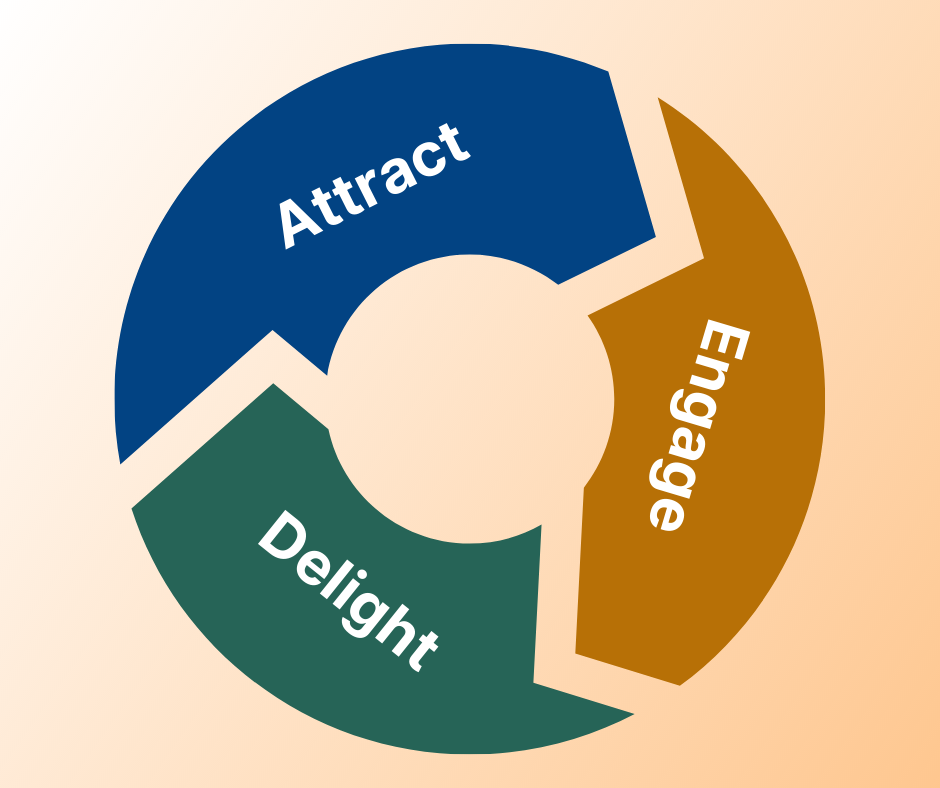
HubSpot’s flywheel model illustrates how satisfied customers fuel continuing revenue and new customer acquisitions.
In the AARRR customer lifecycle, activation is the point at which someone becomes a user–though not always a paying customer. Retention refers to the point at which someone has committed to using the technology, and revenue may come either following activation or later in the users’ journey.
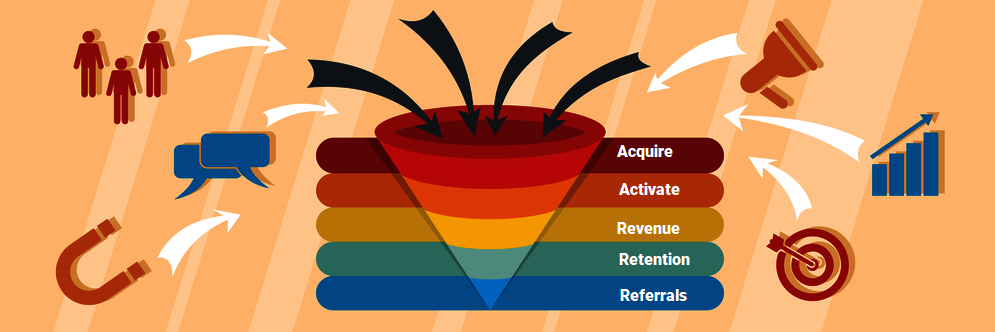
The AARRR framework employs multiple channels and tactics to attract, convert, and retain customers and turn them into brand advocates.
Although often represented as a traditional marketing or sales funnel, these modern marketing approaches pursue revenue and sustainable growth by going beyond the traditional top, middle and bottom of funnel categories. The result is closer to an infinity loop with multiple points of entry and exit, as today’s buyer’s journeys are seldom linear.
Why use inbound marketing?
Implementing customer-focused inbound methodologies across the customer lifecycle from awareness to advocacy lowers customer acquisition costs, reduces churn, increases customer lifetime values and improves ROI.
Inbound marketing methods appeal to modern purchasers and are well-suited for how today’s businesses and individuals shop. In the days before the internet (yes, there was a time before), the seller controlled most of the information available to someone researching a product or service. If a buyer wanted to know the details about a product or its price, often, they would have to go to a store or “hop on a call” with a sale representative.
In many situations, sales professionals could control the narrative and decide what information to share with a prospect and at what stage in their journey. ⛔
Today, a growing number of businesses and consumers want self-service choices for researching and making purchases. If you don’t provide your prospects with the information they want when they want it, someone else will. Plus, unless you’ve built a successful moat, your prospective customers can find other sellers offering comparable products or services.
Consumers no longer need to choose from a few available options. Nor do they need to follow a prescribed path in their discovery process.
A global marketplace puts greater pressure on businesses to differentiate themselves through distinctive branding. Buyers are looking for more than just a good deal, they are looking for businesses that they respect and feel respected by.
In many cases, your unique value proposition has become a unique values proposition. While buyers remain sensitive to price, other factors such as sustainability, social issues, convenience and brand personality are important to their decision-making.
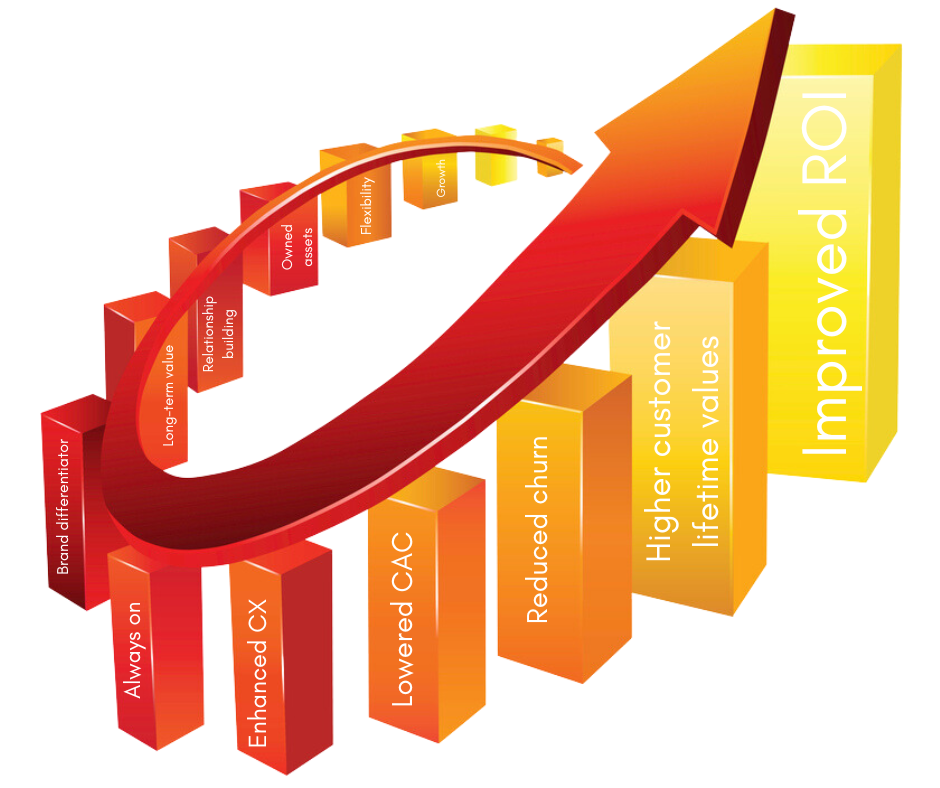
Inbound marketing contributes to a growth strategy by supporting reach and conversions at every stage in the customer lifecycle.
💲Inbound marketing also represents a better long-term investment than paid promotions. When you pay to place an ad, you gain traffic and conversions from that ad only for as long as you continue to pay for its placement.
💲When you create valuable content, you create an owned asset. The bulk of your costs occur on the front end. Once the content is published, it goes to work and keeps working for you with nearly no additional expense.
💲Your costs to returns ratio improves as you repurpose your content and or gained earned media with it. A single content idea can be produced in various formats and styles, updated and distributed on different channels to maximize its returns.
⌛Finally, because your inbound marketing content is prepared in advance and optimized for your ideal audience and their journey stage, it is always on and working for you. Your digital storefront never closes and this virtual arm of your sales team is ever-present to answer incoming questions.
Can inbound marketing go it alone to reach today’s audiences?
Inbound marketing is a powerful method for businesses to grow audiences, gain leads and make sales. But inbound marketing seldom works alone. High-performance businesses use outbound, inbound and other marketing methods to improve their chances of being discovered and stay top-of-mind with potential customers.
Their marketing strategies are integrated, comprehensive and cross-channel. These businesses employ online, offline and combined or “phygital” tactics to meet consumers where they are with engaging, valuable experiences that deliver solutions.
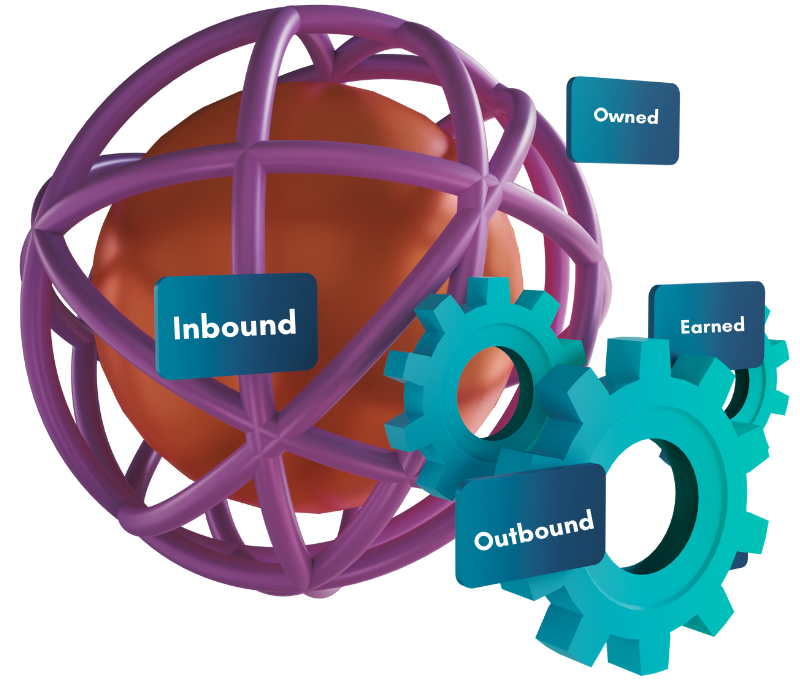
Modern marketing crosses channels and combines methods to assign the right tactic at the right moment to attract, engage, convert and retain your most profitable customers.
When and why do businesses use outbound methods with or instead of inbound marketing tactics?
Outbound or traditional marketing methods take your message to your target audience with varying degrees of aggressiveness. The ads displayed on billboards, commercials aired during television programs and streaming videos, and paid content appearing on your social media feeds or the websites you visit are all outbound efforts.
Outbound marketing can get an unknown brand in front of new audiences quickly, for a price. Also, paid placement is sometimes the only method to get in front of audiences on a specific channel.
Outbound marketing can also help your business catch people’s attention at the moments they are most likely to take action. That’s why restaurants advertise on the radio during rush hour.
Outbound methods can support your brand’s inbound strategy, too.
When you see a paid ad on LinkedIn inviting you to register for a free webinar or download a whitepaper, you’ve witnessed outbound and inbound tactics working together. Similarly, businesses use paid advertising to promote their attraction marketing events such as brand sponsorships, pop-up activations or other in-person and digital events.
Inbound marketing’s primary types of content and delivery channels
How do businesses execute their inbound strategy and deliver the content that draws customers to them?
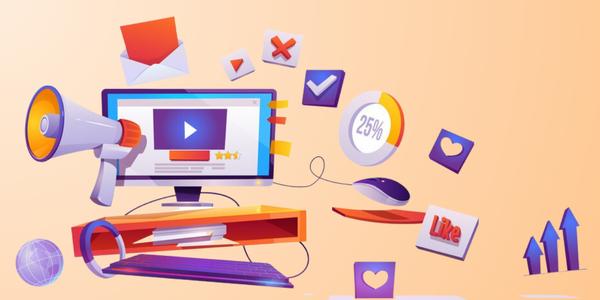
Inbound marketing employs a mix of content formats and delivery channels to be present where (and when) their audiences are seeking answers.
🖥 The first pillar of an effective inbound marketing strategy is your business’s website. Your home page, product or service pages, about page and other pages that house static or semi-static information.
📰 Once you complete and optimize your website, you can expand your inbound efforts to include a blog where you can add new content to attract and inform prospects and customers. Then expand your reach using other digital marketing methods on your website and through other online channels.
📥 Offer downloadable content such as ebooks or video content including webinars or how-to guides to website visitors, through your social media profiles and third-party publishing platforms.
🧮 Free tools such as calculators or templates that are useful to your ideal customer or related to your products or services are a distinctive way to draw more traffic to your website and earn customers’ trust and loyalty. Offering free tools can also earn your business valuable backlinks and shares that build your domain authority and reach.
💬Communicate with prospects and share useful or entertaining information on your social media profiles and use these channels to direct people to your website.
📧 Also, even though it may not seem like an “inbound” method, email marketing presents an opportunity for you to communicate with and deliver engaging content to your most engaged audience. Email sent to subscribers who have opted-in to receive your messages is considered inbound marketing because you’re only sending content to people who have indicated they want to receive.
Like social media, email marketing opens the door for you to have two-way conversations with your audience. Unlike social media, you have more control over who sees each message and under what circumstances. Plus, although email inbox providers have a lot of control over your messages’ deliverability, email is an owned channel. This also distinguishes it from social media’s walled gardens.
Who can you look to for help in developing your inbound marketing strategy?
If you’ve looked for marketing support for your business, you probably know that there are many different types of agencies and individual consultants whom you can call on for help. Some providers are specialists. For instance, I’m a content writer. I create blogs, articles that my clients post on other websites or in third-party publications, social media posts and email copy. I’m familiar with search engine optimization (SEO) practices related to content writing. But I don’t offer technical SEO services.
In contrast, an SEO agency will provide technical SEO advice such as how to set up your website to maximize the chances of it being discovered when consumers search for something using their web browser. Many SEO agencies offer content writing services as well.
Some content writers, by the way, specialize in web site and landing page content and leave the blogging to someone like me. There are also marketing professionals who are experts at not only creating the copy for emails but setting up your email marketing program.
If you are starting from scratch, a growth marketing agency is a good choice. These agencies can help you develop your brand identity and messaging, develop your website and provide you with content or connect you with a writer. I enjoy working with agencies because they handle the parts that I don’t. This allows me to focus my attention and intellectual firepower on creating unique, discoverable content to grow my clients’ audiences.
I have an extensive network on LinkedIn filled with marketers of all kinds. Wherever you are in your marketing journey, I would be happy to help you find the partners you need to take the next step. And, of course, if you’re ready to build your content machine, I’d love to chat.
Let’s put your business in growth mode!